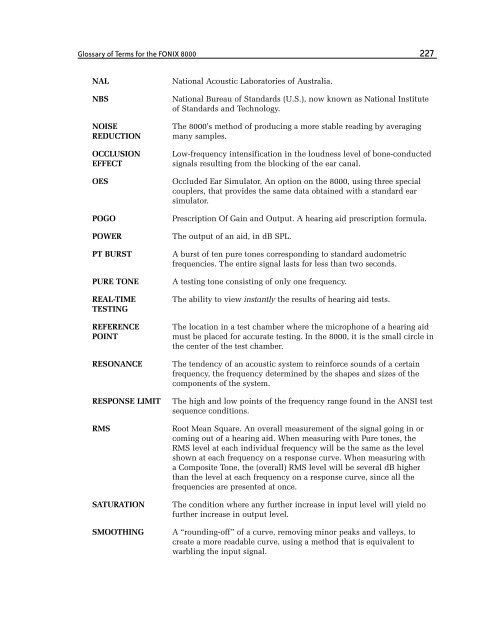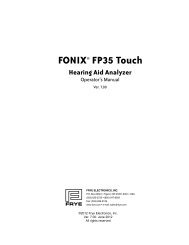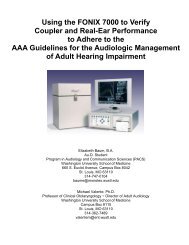FONIX® 8000 - Frye Electronics
FONIX® 8000 - Frye Electronics
FONIX® 8000 - Frye Electronics
You also want an ePaper? Increase the reach of your titles
YUMPU automatically turns print PDFs into web optimized ePapers that Google loves.
Glossary of Terms for the FONIX <strong>8000</strong> 227<br />
NAL National Acoustic Laboratories of Australia.<br />
NBS National Bureau of Standards (U.S.), now known as National Institute<br />
of Standards and Technology.<br />
NOISE The <strong>8000</strong>’s method of producing a more stable reading by averaging<br />
rEDUCTION many samples.<br />
OCCLUSION Low-frequency intensification in the loudness level of bone-conducted<br />
EFFECT signals resulting from the blocking of the ear canal.<br />
OES Occluded Ear Simulator. An option on the <strong>8000</strong>, using three special<br />
couplers, that provides the same data obtained with a standard ear<br />
simulator.<br />
POGO Prescription Of Gain and Output. A hearing aid prescription formula.<br />
POWEr The output of an aid, in dB SPL.<br />
PT BUrST A burst of ten pure tones corresponding to standard audometric<br />
frequencies. The entire signal lasts for less than two seconds.<br />
PUrE TONE A testing tone consisting of only one frequency.<br />
rEAL-TIME The ability to view instantly the results of hearing aid tests.<br />
TESTING<br />
rEFErENCE The location in a test chamber where the microphone of a hearing aid<br />
POINT must be placed for accurate testing. In the <strong>8000</strong>, it is the small circle in<br />
the center of the test chamber.<br />
rESONANCE The tendency of an acoustic system to reinforce sounds of a certain<br />
frequency, the frequency determined by the shapes and sizes of the<br />
components of the system.<br />
rESPONSE LIMIT The high and low points of the frequency range found in the ANSI test<br />
sequence conditions.<br />
rMS Root Mean Square. An overall measurement of the signal going in or<br />
coming out of a hearing aid. When measuring with Pure tones, the<br />
RMS level at each individual frequency will be the same as the level<br />
shown at each frequency on a response curve. When measuring with<br />
a Composite Tone, the (overall) RMS level will be several dB higher<br />
than the level at each frequency on a response curve, since all the<br />
frequencies are presented at once.<br />
SATUrATION The condition where any further increase in input level will yield no<br />
further increase in output level.<br />
SMOOThING A “rounding-off” of a curve, removing minor peaks and valleys, to<br />
create a more readable curve, using a method that is equivalent to<br />
warbling the input signal.
















